What is a wart? The causes, diagnosis and treatment methods will be analyzed in an article by a dermatologist with 37 years of experience.
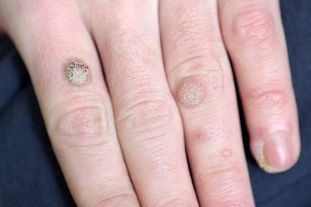
Disease definition. Causes of the disease
Wartsare irregular, lightly treated benign skin lesions in the form of localized growths of papules (nodules) or plaques on the epidermis.
The prevalence of sneezing is 7-12% in adults and 10-20% in school-age children.
Warts are very similar to other skin growths. Usually, a person cannot diagnose the disease on his own, so it is necessary to consult a dermatologist to make a diagnosis.
Human papillomavirus is the cause of warts. The type of virus affects the type of warts that can develop. Thus, each human papillomavirus is transmitted to the tissue during the most characteristic localization.
| HPV type | Preferred localization |
types of warts |
|---|---|---|
| 1 | Feet, knees, palms, hands, fingers |
Plantar and palmar warts, rarely simple warts |
| 2, 4 | Hands, fingers, knees, less - feet |
Simple warts, sometimes plantar, palmar and mosaic warts |
| 3, 10 | Shins, hands, face | Straight sighs |
| 7 | Hands, fingers | Butcher Warts |
| 5, 8, 9, 12, 14, 15, 17, 19-24 |
Face, arms, front torso |
Epidermodysplasia verruciform |
Infection with the virus usually occurs through contact - through direct contact between infected and healthy skin (for example, when you shake your hands) or indirectly (handles, toys, etc. ). Therefore, you can be infected with the human papillomavirus, which causes warts, in different places - on public transport, at school, at work, at home, in contact and in humid environments (swimming pools, saunas, gyms). A small trauma to the epidermis, which contains viruses, as well as inflammation of the skin causes infection.
Contributing to the appearance of sneezes:
- immune deficiencies (including HIV infection);
- hot and humid environment;
- need for professional contact with meat and fish ("butcher's sneezes").
Some types of human papillomavirus are transmitted from parents.
But toads and frogs, despite the horror stories we dreaded as children, can't be infected - this is one of the most popular myths about the disease, which has no basis.
If you find similar symptoms, consult your doctor. Do not self-medicate - it is dangerous for your health!
Wart symptoms
Symptoms will vary depending on the type of urination.
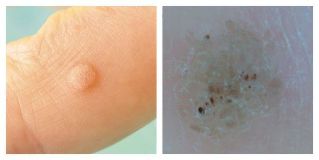
General tel:
- Normally colored round dense papule, 1-10 mm and more.
- The surface of the papule is covered with cracks and layers.
- If the papule is on the finger, the print disappears and is broken. There is the same thing in palm painting.
- Simple warts are found in both single and multiple areas - usually in the most injured areas (hands, fingers, knees).
- When examined with a dermatoscope, the doctor may see small brown spots - thrombotic (clogged) capillaries. Patients often call these points "roots. "This is a key symptom for a doctor: a dermatologist can use a bone marrow to differentiate it from other similar diseases (eg, molluscum contagiosum and keratoma).
Plantar warts:
- Usually the main symptom that causes a patient to see a doctor is pain when walking and walking.
- Such warts are usually located on the legs.
- When you see a doctor, as a rule, the usual colored keratinous, uneven plaques appear, although in the first stage you can see an even, smooth papule. With keratinization, capillaries can be seen only when the keratinized layer of skin is removed.
- The skin shape of the floor is distorted.
- Plantar warts are usually solitary, but there are also 2-6 warts;
- These warts are often confused with corn (especially dry) - this is a description of the problem that patients generally come to see.
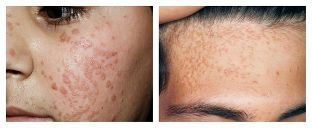
Straight (immature) wart:
- It looks like a round, clear, smooth papule, 1-5 mm in size, normal, pink or brown.
- Very often it appears on the hands, on the cheeks, on the face.
- There are always several such sighs - they are in groups.
Verruciform epidermodysplasia:
- Large, round, numerous mixed neoplasms of normal pink or brown color.
- Often seen in front of face, arms, torso.
- Can be confused with keratoma, tumors and skin cancer.
Wart pathogenesis
When it enters the body, the human papillomavirus can be hidden for a long time - the person does not even know about its existence. When favorable factors for the virus appear, they begin to "multiply" in the epithelium and cause tissue changes.
Unlike other viruses, human papillomavirus does not destroy epithelial cells on its own - they naturally die in the process of keratinization and itching.
Local factors and the state of the immune system affect the spread of infection. For example, people with HIV infection or kidney transplantation are more likely to develop warts. In addition, these neoplasms are often difficult to treat. With normal immunity, the virus does not affect the deeper layers of the skin, so many people get warts on their own after a few months.
The main stage in the appearance of sneezes is the acceleration of cell division and growth with the help of the virus. This rapid metabolism causes the skin layers to thicken. Because the tissue grows in a certain, small area, a tubercle is formed, which is called a wart.
Node classification and development stages
There is no generally accepted classification forsneezes. But there are a few common types:
- Common wartsare the most common type (these are 70% of warts). Such neoplasms are not felt and cause only aesthetic discomfort to a person.
- Plantar hernia- visible under the feet, painful, therefore requires treatment. Skin trauma due to uncomfortable, tight, skinny shoes contributes to the formation of such a rash.
- Straight sneezing- more common in young people, teenagers. This is due to the unstable hormonal background of young people and affects the whole body. Straight sneezes are usually almost invisible.
- Senile sneezes- typical for adults. They often appear on the part of the body covered with clothing, but can occur on the face and hands. In the absence of discomfort, such warts should not be treated - healing may be slower in older people than in younger people due to a slow metabolism.
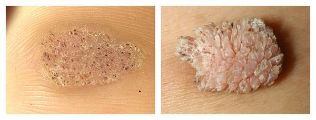
Other authors distinguish several more such warts:
- Mosaic sneezes(HPV 2, 4) - neoplasms at the base of the palm. They appear as hyperkeratosis, a thickening of the stratum corneum (usually anterior) covered with deep cracks.
- Cystic sneezing(HPV 60) is a very rare type of growth on the foot. It is a soft knot with cracks. When opened, a white-yellow discharge resembles a curl.
- Filiform wartsare thin horny outgrowths near the mouth, nose, or eyes.
- Butcher's warts(HPV 7) - appear on the hands and fingers of people who are in constant contact with meat and fish. It is presented in the form of hypertrophic neoplasms similar to cauliflower, but of normal color.
In addition, the types of warts vary depending on their location.
For example, anogenital sneezes are new tumor-like diseases that appear in the genitals (especially where the skin passes into the mucous membrane). These are usually caused by HPV types 6 and 11.
Complications in the node
The main reason why wart patients go to the doctor is an aesthetic defect that affects the patient's quality of life, self-confidence and can develop many complexes. Complications include cracking of the surface of the wart and the addition of infection, and some types of sneezing include pain when walking.
Skin warts usually do not turn into malignant neoplasms, they are very harmless, but very rarely, such a complication can still occur in people with compressed immunity.
Other complications occur when you try to remove the growth yourself. This can lead to inflammation and aesthetic defects in the form of wounds, as well as further spread of the virus through the skin. Therefore, after a wart appears in the morning, several people may wake up with a new one.
Remember that under the guidance of a wart can hide a completely different disease that can not be diagnosed without the advice of an experienced doctor.
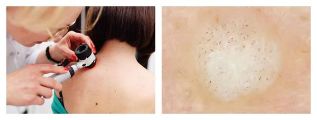
Dart diagnosis
Generally, an examination (clinical picture) and a history (medical history) are sufficient to make a diagnosis.
To confirm the diagnosis, the doctor may perform a histological examination - a study of neoplasm cells.
Differential diagnosis - it is very important to distinguish warts from other diseases. For example,common sneezesshould be distinguished from the following diseases:
- Molluscum contagiosum- more visible on the body and genitals, less on the hands and feet. It is the hemisphere that makes an impression on the surface; When pressed from the sides, a bleached "gruel" appears.
- Epidermal armed nevus- more often alone, since birth. Rises above the surface of the skin, often covered with hair.
- Basaliomais a tumor in the form of a rounding of crusted nodules in the center. Typical for adults.
Palmar-plantar wartsshould be distinguished from the following diseases:
- Keratoderma- extensive areas of keratinization and inflammation of the skin. There are no coagulated capillaries.
- Palmar-plantar syphilids- numerous painless neoplasms that erode the skin along the periphery. The reaction to syphilis is positive.
- Corn- generally painless, can only hurt when pressed vertically.
The doctor must distinguish other warts from a number of other diseases. If another pathology is suspected, additional diagnostics may be indicated (eg, detection of antibodies to viruses, CT, or MRI).
Wart treatment
Warts are treated for aesthetic purposes and to improve the patient's quality of life. It can be prescribed by a doctor only after an examination and an accurate diagnosis. Independent attempts to get rid of a wart are unacceptable, because a patient without medical education and the necessary equipment can not accurately diagnose the disease, and complications after such "treatment" occur more often without recovery.
There are several ways to treat warts. All of them are generally performed under the supervision of a doctor, and some are performed only in the treatment room of the clinic.
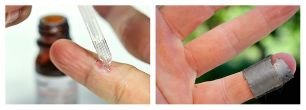
Chemotherapy
Milk-salicylic collodion and salicylic patches are used to get rid of cigars. The percentage of drugs and the method of their use (longevity of plasters, applications, etc. ) depends on the distribution and localization of the neoplasm.
Zinc and 2-chloropropionic acid solutions may also be used. In this case, a chemical is applied to the pre-cleaned surface of the wart (depending on the type of wart) until it changes color. The procedure is repeated several times after 7, 14 and 21 days. The tissue is removed mechanically before each procedure.
Another chemical method is a combination of nitrogen, vinegar, oxalic, lactic acids and copper nitrate trihydrate. Only relatively small neoplasms are treated in this way - up to 5 mm. The solution is also left to change the color of the wart. After 3-5 days, the patient comes for a re-appointment, and if necessary, a second procedure is scheduled within 1-4 weeks.
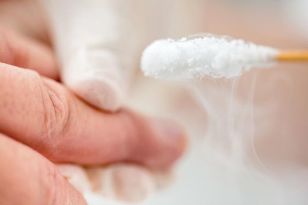
Cryodestruction
This method involves freezing the wart with liquid nitrogen: a moistened liquid is pressed against the damaged skin for 1-5 minutes (the surrounding tissue is trapped by a few mm). Some lesions require several treatments over a four-week period.
The main disadvantages of cryodestruction are the painful and delayed effect compared to other methods, which often require only one procedure to eliminate.
Electrocoagulation
Under the influence of an electric current, sneezes are removed in layers. Such an operation is performed under local anesthesia.
This method is more effective than cryodestruction, but has a significant drawback: electrocautery often leaves scars at the site of wart removal. This method will not be most suitable for patients undergoing cosmetic repairs.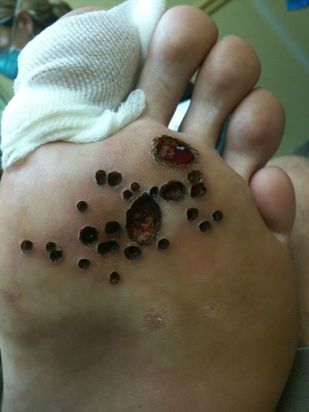
Laser destruction
The laser also removes warts. The light guide makes contact with the skin for a few seconds to three minutes, depending on the size. Then the visible wound is excited and the bottom of the wound is treated with laser again. The patient is then instructed on how to manage the wound. The operation itself is performed under local anesthesia.
Radio wave operation
Radiofrequency surgery is one of the most modern and gentle methods of removing some unpleasant neoplasms, including warts.
The method is based on the generation of electromagnetic waves of different frequencies: from 100 kHz to 105 MHz. During the procedure, the tissues resist the passing waves, so molecular energy is released in the cells that heat the skin. Under the influence of heat, the cells actually evaporate - a neat cut is obtained. At the same time, no mechanical force is applied to the affected tissue.
Advantages of this method:
- security;
- rapid wound healing;
- gives a good cosmetic effect - scars and wounds are excluded;
- relative painlessness - local anesthetic is applied before mini surgery;
- Elimination of secondary infection due to automatic disinfection of the electrode when the device is turned on.
The effectiveness of this method is known all over the world, but it is very difficult to find a clinic that uses the method of radio wave surgery.
Which treatment method to chooseAll of the above methods have several drawbacks:
- In the first two months of the week, the operated area looks attractive - peeling, darkening of tissues. This should be taken into account if sneezing is found on visible parts of the body (for example, the face).
- Unpleasant odor and some pain during surgery.
In addition, each of these methods has a contraindication, which you should learn in consultation with a dermatologist.
But the main drawbackis the high probability of recurrence 'xx / em>, especially if the sneezes are wide and wide. With each of these methods, doctors are now struggling not with the root cause of the disease, but with its consequenceshuman papillomavirus cannot be cured.
Therefore, therapy is directed:
- or destruction of neoplasms at the site of application of the virus;
- or to stimulate the antiviral immune response;
- or a combination of these approaches.
The most destructive treatment is used. Their efficiency reaches 50-80%.
Uterus is generally not a contraindication to surgical treatment. Therefore, it is also used in the treatment of sneezing in many children (including radiofrequency surgery). The exception is the chemical removal of sneezes due to adverse reactions to substances.
What to do after the operation
Be sure to follow your doctor's advice after these surgeries.
After the tumor is removed by any of the methods presented, the doctor will usually prescribe treatment for the raised area. It is forbidden to remove the "peels", soak the wound and expose it to direct sunlight.
If the patient is constantly suffering from warts, then he should consult an immunologist - perhaps drug therapy will be required, which will lead to increased immunity to the manifestations of human papillomavirus.
Forecast. Prevention
If the patient does not have an immune deficiency, the warts may go away on their own, but this will take a long time - from a few months to several years. Thus, in 65% of cases, sneezes regress independently within two years. If the wart is still in place after two years, it is advisable to remove it. It is recommended to remove more than one growth immediately.
With normal immunity and proper removal (depending on the size and type of sneezing) it is possible to remove pathogenic tissue and achieve a good cosmetic effect. With reduced immunity and other predisposing factors, the remaining papillomavirus in the human body causes a relapse.
There is no specific disease prevention. But is infection inevitable?
If you follow a few rules, you can reduce the likelihood of a virus:
- Avoid walking barefoot in public places where there is a risk of skin damage and viral infection.
- Choose quality shoes, change them often. Try to dry your feet. Heat and humidity are excellent cultivators for human papillomavirus.
- To prevent periungual sneezing, consult only approved nail specialists and make sure they use sterile instruments.
According to the World Health Organization (WHO), the quadruple vaccine against human papillomavirus is also highly effective in preventing anogenital warts. There is currently no vaccine to prevent other types of warts.
If you find a wart, don't try to cut, cut and remove it yourself - this way you can help the inflammation and the virus to spread further through the skin. After this "removal", you can wake up with it in the morning instead of a wart.















































































